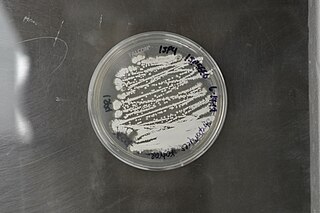
Streptomyces is the largest genus of Actinomycetota, and the type genus of the family Streptomycetaceae. Over 700 species of Streptomyces bacteria have been described. As with the other Actinomycetota, streptomycetes are gram-positive, and have very large genomes with high GC content. Found predominantly in soil and decaying vegetation, most streptomycetes produce spores, and are noted for their distinct "earthy" odor that results from production of a volatile metabolite, geosmin. Different strains of the same species may colonize very diverse environments.

Glufosinate is a naturally occurring broad-spectrum herbicide produced by several species of Streptomyces soil bacteria. Glufosinate is a non-selective, contact herbicide, with some systemic action. Plants may also metabolize bialaphos and phosalacine, other naturally occurring herbicides, directly into glufosinate. The compound irreversibly inhibits glutamine synthetase, an enzyme necessary for the production of glutamine and for ammonia detoxification, giving it antibacterial, antifungal and herbicidal properties. Application of glufosinate to plants leads to reduced glutamine and elevated ammonia levels in tissues, halting photosynthesis and resulting in plant death.

Streptomycetaceae is a family of the class Actinomycetota, making up the monotypic order Streptomycetales. It includes the important genus Streptomyces. This was the original source of many antibiotics, namely streptomycin, the first antibiotic against tuberculosis.

Streptomyces griseus is a species of bacteria in the genus Streptomyces commonly found in soil. A few strains have been also reported from deep-sea sediments. It is a Gram-positive bacterium with high GC content. Along with most other streptomycetes, S. griseus strains are well known producers of antibiotics and other such commercially significant secondary metabolites. These strains are known to be producers of 32 different structural types of bioactive compounds. Streptomycin, the first antibiotic ever reported from a bacterium, comes from strains of S. griseus. Recently, the whole genome sequence of one of its strains had been completed.

Clavams are a class of antibiotics. This antibiotic is derived from Streptomyces clavuligerus NRRL 3585. Clavam is produced to form a new β-lactam antibiotic. This class is divided into the clavulanic acid class and the 5S clavams class. Both groups are the outcomes of the fermentation process produced by Streptomyces spp. Clavulanic acid is a broad-spectrum antibiotic and 5S clavams may have anti-fungal properties. They are similar to penams, but with an oxygen substituted for the sulfur. Thus, they are also known as oxapenams.
Streptomyces cinnamoneus is a bacterium species from the genus of Streptomyces which has been isolated from soil in Japan. Streptomyces cinnamoneus produces duramycin A, duramycin B, duramycin C, carbomycin, cinnomycin and fungichromin.
Streptomyces diastaticus is an alkaliphilic and thermophilic bacterium species from the genus of Streptomyces. Streptomyces diastaticus produces oligomycin A, oligomycin C, rimocidin and the leukotriene-A4 hydrolase-inhibitor 8(S)-amino-2(R)-methyl-7-oxononanoic acid. Streptomyces diastaticus also produces gougerotin and diastaphenazine and the antibiotic ruticin.
Streptomyces exfoliatus is a bacterium species from the genus of Streptomyces which has been isolated from soil. Streptomyces exfoliatus has the ability to degrade poly(3-hydroxyalkanoate). This species produces exfoliatin and exfoliamycin.
Streptomyces haliclonae is a bacterium species from the genus of Streptomyces which has been isolated from the sponge Haliclona sp in the Chiba prefecture from the coast of Tateyama City in Japan.
Streptomyces hiroshimensis is a bacterium species from the genus of Streptomyces which has been isolated from soil. Streptomyces hiroshimensis produces the red pigment prodigiosin.

Streptomyces katrae is a bacterium species from the genus of Streptomyces which has been isolated from soil in India.
Streptomyces microflavus is a bacterium species from the genus of Streptomyces which has been isolated from soil. Streptomyces microflavus produces nemadectin, fattiviracin A1, milbemycin and deoxyuridines. Streptomyces microflavus also produces the ionophore valinomycin. Streptomyces microflavus is also known to cause potato common scab disease in Korea.
Streptomyces mobaraensis is a spore forming bacterium species from the genus of Streptomyces. Streptomyces mobaraensis produces bleomycin, detoxin, piericidin A, piericidin B, reticulol and transglutaminase. Streptomyces mobaraensis is used in the food industry to produce transglutaminase to texture meat and fish products.
Streptomyces mutabilis is a bacterium species from the genus of Streptomyces which has been isolated from soil. Streptomyces mutabilis produces the antibiotic mutalomycin. Streptomyces mutabilis UAE1 has been found to promote plant growth in gray mangroves under greenhouse conditions by producing polyamines putrescine (Put), spermidine (Spd), and spermine (Spm).
Streptomyces poonensis is a bacterium species from the genus of Streptomyces. Streptomyces poonensis can degrade 4-hydroxybenzoate.

Streptomyces puniceus is a bacterium species from the genus of Streptomyces which has been isolated from soil. Streptomyces puniceus produces vinactane and viomycin.
Streptomyces rubiginosus is a bacterium species from the genus of Streptomyces which has been isolated from soil. Streptomyces rubiginosus produces glucose isomerase. glucose isomerase from Streptomyces rubiginosus can be used to texture fish and meat products.
Streptomyces virginiae is a bacterium species from the genus of Streptomyces which has been isolated from soil. Streptomyces virginiae produces actithiazic acid, virginiamycins and cycloserine. Streptomyces virginiae also produces monensin A, monensin B, monensin C, monensin D, actithiazic acid.
Streptomyces vitaminophilus is a bacterium species from the genus of Streptomyces which has been isolated from soil in the Nagano City in Japan. Streptomyces vitaminophilus produces the pyrrolomycin complex.
Streptomyces yatensis is a bacterium species from the genus of Streptomyces which has been isolated from ultramafic soil in New Caledonia.





